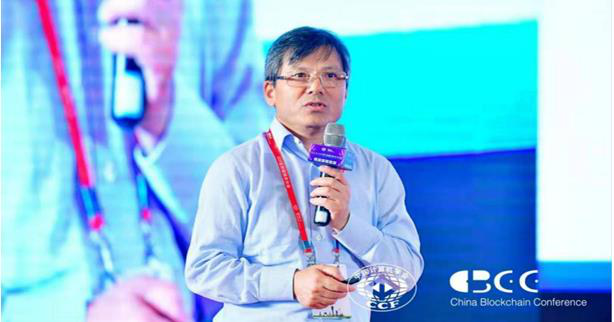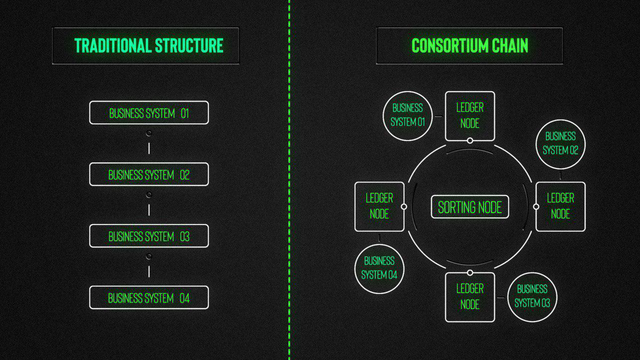Exploration of Application of Blockchain Technology
By the end of 2018, nine Chinese provinces had launched blockchain industry funds totaling nearly 40 billion yuan ($% ~6B US). By February 2019, Beijing, Shanghai, Chongqing, and other cities had issue blockchain policies to encourage and support blockchain development for relevant industries.
As early as 2017, Chen Chun, an academic of the Chinese Academy of Engineering, said that blockchain technology has evolved to support a consortium chain. At this year's CCF, China Computer Federation, Blockchain Technology Conference, August 2019, academician Chen once again spoke about the consortium chain. He pointed out: 1) the consortium chain supports collaborative administration, and provides high performance, high availability, and high security and privacy; 2) the consortium chain is the main focus of China's blockchain development for now and the foreseeable future.
Overnight, Chinese major mainstream media is highlighting blockchain and unprecedented opportunities for the development of blockchain.
Academician Chen Chun restated his opinions about the promise of blockchain at an October 2019 meeting and has become a "Web academician star". China sees the future of blockchain and its benefits for China through Chen Chun words.

What is the consortium chain? What is the reason for Mr. Chen optimism about the consortium chain?
What is the Consortium Chain?
Blockchain can be classified into two types: public blockchain and permissioned blockchain.
For the public chain, its entire ledger is open to the public, and anyone can query or send transactions on the public chain. Anyone can create and cancel their nodes on the public chain without notification or requesting authorization. The public chain has the highest degree of decentralization and the strongest degree of anonymity.
There are two types of the permissioned chain: private chain and consortium chain. The private chain typically belongs to one organization, which owns the security rules of the private chain and decides who has the read and/or write authority to the ledger. The degree of decentralization and anonymity of a private chain is the lowest.
The consortium chain is between the private chain and the public chain. The consortium chain is a multi-centralized system, and the nodes are maintained by several authorized centralized organizations. The accounting rules and read-write permissions of the consortium chain are jointly agreed to by all members of the consortium chain. Different members may have different read-write permissions.
At this point, you may still be confused about the consortium chain. The comparison of the data transmission methods between fixed and separate systems and the consortium chain below may help you have a better understanding.

To compare a traditional data processing model with a Consortium Chain: consider a structure of separate business systems sequentially connected, so the business decision and data flows from system 1 to system 2, to eventually the last system. All parties involved in the business process have their independent systems and databases. To transfer data from one system to the next, all parties in the system need to develop an interface that links each system with the previous and the next system. If the link is broken during the transfer – due to authorization issues or interface issues, the data cannot be transferred further. and the transaction is halted.
Consider that data can be processed in parallel in the consortium chain, and those actions that are dependent on previous actions will execute in the required sequential order. For the same business process as discussed in the previous paragraph, each party (system) has a consistent ledger (database) and the same set of interfaces. All parties manage nodes and synchronize data changes in real-time. Compared with the serial information system (first example), the consortium chain only changes the method of managing and storing data and how the data decisions flow through the system.
Why can’t public and private chains be as simple as the consortium chain?
Consortium Chain accommodate shared central administration while utilizing the advantages of blockchain.
Most or all public chains in the world incorporate cryptocurrency. Cryptocurrency is the most widely-used application of the public chain. However, the public chain and cryptocurrencies do not meet the current legal and regulatory requirements in China, and in principle, cannot be legally used and operated in China. The private chain has no cryptocurrency value because it operates within a certain organization with limited scope and scenarios.
The consortium chain is different. It has a wide range of application scenarios and can effectively leverage the blockchain technology.

For example: in 2019 the Ministry of Housing and Urban-Rural Development, and the China Construction Bank set up a PF (provident fund) consortium chain to manage the interconnection of the provident fund management systems in 491 cities across the country. How does China benefit from this?
Suppose Xiao Ming has worked in Beijing for three years, and now he wants to work in Hangzhou. He needs to transfer the PF to Hangzhou. If there was no PF consortium chain, Hangzhou's PF center would have to obtain Hangzhou's provident fund data from Beijing’s PF center, which would be time consuming and require authorization. Now with the PF consortium chain, Hangzhou’s PF center can directly query Beijing's PF data. PF consortium chain greatly improves the query efficiency of PF data.
PF consortium chain also cuts off a lot of intermediate links thus helping people get things done more efficiently. Suppose Xiaoming wants to buy a house in his hometown, Chongqing, with his girlfriend after working in Hangzhou for 2 years. Xiaoming needs to apply for the certificate of PF deposit. Without the PF consortium chain Xiaoming needs to apply for paper certificates in Hangzhou and then hand them over to the PF center in Chongqing, which is time-consuming and labor intensive. Now Xiaoming can authorize the Chongqing PF center directly online to query his Hangzhou PF deposit certificate, quickly addressing the situation.
After the establishment of the PF consortium chain, the PF systems in different cities adopt the same database mechanism and data transmission with no need for separate interfaces, which results in the cost savings of developing interfaces.
Furthermore, centralizing the administration of the PF Fund expands the supervision scope but reduces the total supervision cost.
From the above example, we can see that by establishing a shared ledger (shared database) mechanism among multiple business parties, the consortium chain consolidates the security administration among all business parties, and also has many advantages such as improving data query efficiency, reducing intermediate links, reducing development costs, etc.
At present, due to the high technology threshold of blockchain, we must be able to effectively apply the consortium chain technology to different industries – without “reinventing the wheel”, thus saving the development cost.
Realize one-stop chain building and reduce the development cost of a consortium chain
Blockchain is still in the early stage of development, and domestic consortium chain solutions are very scarce. As a one-stop chain building provider, NULS chain factory provides a comprehensive consortium chain solution, while reducing the development cost.
NULS chain factory reduces development cost from three aspects:
1.NULS microservice architecture enables blockchain customization.
2.NULS provides general application functional components to enable re-use of functional components for different customers and applications.
3.Connecting with a cloud service provider to utilize the automatic deployment of nodes.
NULS chain factory is a graphical chain building platform. Based on the microservice architecture, the chain factory team separates the underlying functions such as consensus, ledger, block into different modules. The microservice architecture reduces the development difficulty and time for NULS to enhance existing features and add new features to the consortium chain.
The integration of microservices enables the NULS blockchain system to incorporate loosely coupled modules each independent from other modules with respect to software and function. The chain factory will provide a rich module warehouse. Users can assemble a consortium chain by selecting the desired modules from the module warehouse. If a function/module is not available, the user can develop the business module, upload the module, and incorporate the module to complete building the chain. The independence of the modules enables the chain factory to customize any consortium chain.
In order to provide the application scenarios required by a consortium chain, the chain factory will provide the general functional components: account authorization -- users can set different permissions for different roles; supervision mechanism -- users can introduce supervision nodes to monitor the data on the chain and inappropriate usage; on-chain governance -- consortium members can vote for a proposal such as blockchain maintenance, member management, and other governance tasks.
The chain factory will provide various general application models of consortium chains based on these functional components. With the help of these models, users can quickly tailor the consortium chain to their application requirements, deploy their configured consortium chain, develop applications to meet their needs, and migrate their applications to their chain.
In addition to the chain building, the chain factory will also help users “walk the last mile”. After the customization of the consortium chain, users need to deploy the nodes of the consortium chain. By selecting the appropriate Cloud Server package, the chain factory will connect with the cloud service provider so that users can easily complete the deployment and management of nodes in the chain factory.
NULS chain factory provides full customization, application portability, and automatic deployment of nodes, making it possible to achieve one-stop chain building. This will effectively help the growth and usability of consortium chain technology.
Conclusion
The mainstream media once pointed out that the popularity of the consortium chain will have a tremendous impact on the global information industry, and blockchain technology is a new information revolution. But in the early stage of blockchain, the high cost of chain building is the biggest hurdle. Therefore, reducing the development cost of the blockchain is the overriding task for blockchain technology development.
NULS Chain Factory can effectively reduce the cost of building a consortium chain. With the help of products such as the chain factory, different industries can combine consortium chain technology with existing businesses to improve efficiency and save costs.
The application of consortium chain technology is conducive to accelerating China's exploration of blockchain technology, positioning China to play a leadership role in the information revolution of blockchain.
Reference:
“Clarify Matters: Why blockchain is a new information revolution”, Shan Zhiguang, He Yifan, from people.cn.
Join our social media and explore NULS!
Twitter Follow now: https://twitter.com/Nuls
Reddit Subscribe now: https://www.reddit.com/r/nulsservice/
Telegram Join now: https://t.me/Nulsio
Facebook Subscribe now: https://www.facebook.com/nulscommunity
Join the community in our migration to Hive, a community built blockchain for the community. All Steem account holders will receive equivalent stake on the new Hive blockchain.
Please follow @innerhive on twitter for more information.
Downvoting a post can decrease pending rewards and make it less visible. Common reasons:
Submit